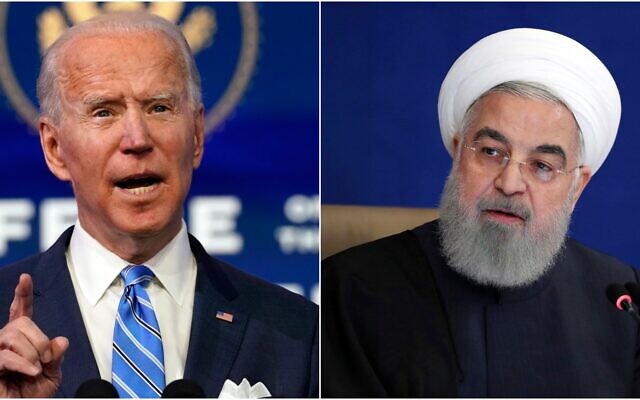Three sources told Reuters on the 8th that in order to restart the comprehensive agreement on the Iranian nuclear issue, the U.S. government is considering a series of plans, including the United States and Iran to return to the agreement in a “small step” manner, without fully fulfilling their obligations under the agreement at one time, thus breaking the deadlock.
[Consideration]
A source familiar with the U.S. government’s assessment of the Iran nuclear agreement said that the so-called “one small step for one small” plan of the United States and Iran means that the United States has given Iran some “economic benefits”, but less benefits than lifting sanctions against Iran.
Iran needs to stop further breaking through the restrictions on nuclear activities imposed by the Iran nuclear agreement, or even “reversing”. Some previous breakthroughs.
The source said that the U.S. government is “considering seriously” various plans.
Iran reached an Iran nuclear agreement with the United States, the United Kingdom, France, Russia, China and Germany in 2015.
Under this agreement, Iran promised to limit its nuclear program in exchange for the lifting of sanctions by the United Nations, the United States and the European Union.
In May 2018, the U.S. government led by then-President Donald Trump unilaterally withdrew from the Iran nuclear agreement, and then restarted and added a series of sanctions against Iran.
Since May 2019, Iran has gradually suspended the implementation of some of the terms of the agreement, but said the measures taken are “reversible”.
Iran and the United States have recently exchanged terms for their return to the Iran nuclear agreement, requiring each other to take the first step.
The United States asked Iran to resume the agreement, while Iran asked the United States to lift sanctions.
Another source told Reuters on the 8th that once the new government led by U.S. President Joseph Biden determines that the negotiations on the full implementation of the Iran nuclear agreement between the United States and Iran are too long, it is possible to adopt a compromise solution.
In order to save the Iran nuclear agreement, the Iranian government previously proposed a “synchronous” plan.
Iranian Foreign Minister Mohamed Zarif said on the 1st that Iran and the United States should simultaneously take the actions needed to return to the agreement or solve the current dilemma.
[Options]
Since the United States withdrew from the Iran nuclear agreement and imposed sanctions on Iran, the relationship between the two countries has deteriorated.
Reuters predicts that once the “small steps for small steps” plan is implemented, the relationship between the two sides may ease slightly.
The news agency reported that in order to save the Iran nuclear agreement, the economic benefits provided by the United States to Iran may include no longer limiting Iran’s access to IMF loans and allowing Iran to use the credit instruments proposed by the European Union.
A Western diplomat said that Iran’s application for an IMF loan is very likely to be approved, and that the EU’s credit instruments for Iran are “reasonable and feasible”.
The United Kingdom, France and Germany set up the “Trade Exchange Support Tool” (INSTEX) settlement mechanism in early 2019 to seek to barter with Iran and run the spread between European local exporters and importers to avoid direct capital transfers, with a view to allowing EU member states and Iran to evade U.S. sanctions and continue.
Continue trade. However, this mechanism has not worked so far.
In September 2019, the French government proposed to provide Iran with a credit line of $15 billion in exchange for Iran to resume fulfilling all the terms of the nuclear agreement.
When the French side proposed the plan, it did not specify the loan provider and stressed that the loan issuance needed to be acquiesced in by the U.S. government.
[Uncertained]
Three sources stressed to Reuters that Biden has not yet determined a strategy on how to return to the Iran nuclear agreement.
The current position of the U.S. government remains that Iran must fully resume the implementation of the Iran nuclear agreement before the United States can lift sanctions.
A spokesman for the U.S. State Department, which asked for no names, said that the Biden administration will also consult with Congress and allied countries on the restart of the Iran nuclear agreement.
It is not clear how long it will take for the Biden administration to finalize the strategy.
A bill passed by the Iranian parliament last December requires that if the United States does not relax sanctions against Iran in late February, the Iranian government should further break through the restrictions of the Iran nuclear agreement.
Iran’s presidential election is scheduled for June, and the atmosphere of domestic elections is getting stronger. Western media speculate that if a hardline president is elected, the future of the Iran nuclear agreement is unpredictable.
Reuters reported that once the United States relaxes any sanctions against Iran and Iran does not fully implement the agreement, Republicans will criticize the new government led by Democratic President Biden.
The Biden administration “should be aware of the reality of 2021, not stay in 2015” Nikki Haley, the former U.S. Permanent Representative to the United Nations, tweeted on the 7th.
She hinted that the reality is that Iran has gradually suspended the implementation of some of the terms of the agreement, and once the United States makes concessions but does not get enough response, the gains will outweigh the losses.



